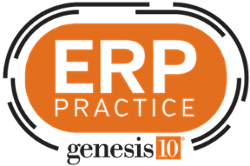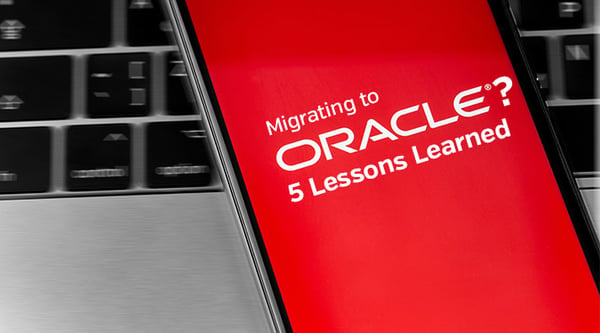Today’s ERP projects are complex, whether migrating to the cloud or another platform, such as SAP to Oracle.
Presenting a case study that describes such a project at a market-leading commodities company during a new Genesis10 ERP Practice webinar, Jeff Janowich, OTC (Order to Cash) Solution Architect at Genesis10 shared these lessons learned:
![]() Understanding the maturity level of the project management team is critical. The maturity level of the team was not at a level to be able to manage this project successfully.
Understanding the maturity level of the project management team is critical. The maturity level of the team was not at a level to be able to manage this project successfully.
![]() A pre-implementation assessment provides a invaluable knowledge base that opens eyes to what needs to be done to meet the timeline.
A pre-implementation assessment provides a invaluable knowledge base that opens eyes to what needs to be done to meet the timeline.
![]() When implementing commercial off-the-shelf software, maximize standard functionality and minimize customization. The more you customize, the larger footprint you have to carry along.
When implementing commercial off-the-shelf software, maximize standard functionality and minimize customization. The more you customize, the larger footprint you have to carry along.
![]() Implement a change control process that requires stakeholders to document business impact and therefore justification of the requirement. This helps minimize scope creep.
Implement a change control process that requires stakeholders to document business impact and therefore justification of the requirement. This helps minimize scope creep.
![]() Build robust project methodology documentation including project charter, development standards, instant strategy, naming standards, functional and technical specification documents and testing standards. “Your project plan should be a living and evolving artifact that’s modified against the actual velocity of the project and is reviewed and recalibrated as necessary,” Janowich said.
Build robust project methodology documentation including project charter, development standards, instant strategy, naming standards, functional and technical specification documents and testing standards. “Your project plan should be a living and evolving artifact that’s modified against the actual velocity of the project and is reviewed and recalibrated as necessary,” Janowich said.

Janowich was one of three expert panelists participating in a new Genesis10 ERP Practice webinar, ERP Migration: Lessons Learned. Also on the panel were: Ivanka Menken, Co-Founder and CEO of The Art of Service, Gerard Blokdyk, Co-Founder and President, also of The Art of Service. Menken and Blokdyk were on hand to discuss self-assessments and knowledge graphs, tools which can help ease implementation of projects such as Oracle migrations. I had the pleasure of moderating this thought-provoking discussion. Find out about future and past ERP webinars.
Oracle Migrations: Lessons Learned Video
Setting the Stage
In his role, Janowich manages all aspects of an OTC value stream implementation at a market-leading commodities company that has heavy requirements on rail and truck shipping, or transportation management. The company has been running SAP R/3 for more than 25 years. The system is so customized that it can’t be upgraded, and R/3 is no longer supported. The system has been optimized over its lifespan, allowing the company to operate with minimal staff. Two system support analysts working on the project since inception are retiring. With these factors, the company realized it was time to move its transportation management system to a new ERP platform with a timeline that minimizes risk.
Since the parent company was running Oracle EBS (E-Business Suite), it made sense to move from SAP to Oracle EBS 12.2.9. The decision leads to the question: What to do about transportation requirements? Build a transportation management system or implement OTM (Oracle Travel Management) or other transportation management system?
“Implementing a packaged solution like OTM provides opportunities to continuously capitalize on new functionality through upgrades and releases,” Janowich said. “When you build, it will be exactly to company requirements. But you need to keep in mind that when you customize, you have a significant anchor that you have to drag along every time you want to EBS to the latest version.”
Other key planning considerations include: Which approach to take to the efficiency customizations of the existing SAP system.
What Happened Next
Planned to be completed in 12-18 months based on timeline drivers of key support staff, the project has been running for two years and seven months, with the current go-live putting duration at more than three years. Not only exceeding the original timeline, the project also is over budget, by five times, leading to dismissal of the project manager for not understanding the scope of the project and not properly planning and managing it.
“Because of the inappropriate and rushed timeline, the scope of work and staffing needed to get it done, the project was run in constant changing priorities and general delivery chaos,” said Janowich. “System integration tests failed and weren’t completed.”
Then, about a year ago, the company hired a new project manager experienced in methodology and project planning. SIT3 (System Integration Testing) has gone very well with scripts achieving 90% plus success rates.
Currently, the project is in SIT4 with a UAT (User Acceptance Testing) planned for later this year.
What Went Wrong?
Janowich ticked off a list:
One, managing the project in-house with a project management team inexperienced in complex ERP migrations. Despite Janowich’s efforts to raise risks with the team, they didn’t take mitigating actions.
Two, building a custom transportation management system. Packages were not evaluated for fit and purpose and were immediately positioned as out of scope.
Three, the scope to build custom transportation management requirements was drastically underestimated.
“Building everything they have today means that all efficiencies built into the SAP R/3 system set expectations of what Oracle could do,” Janowich said. “This resulted in a huge customization footprint and endless continuous growth of scope creep.”
The scope was drastically underestimated as well. Because of this, the project was not staffed correctly from a consultant and business perspective.
And the timeline was one of the main business drivers.
Not expected was the pandemic which forced a work-from-home dynamic leading to the team running large test cycles remotely. Unchartered waters for the team--and for many others at the time—this part of the project wasn’t well planned and executed.
These are just a few.
“In a situation like this, you need to be in control of the project,” Janowich said. “Yet you often don’t have the right foundation prior to going into the project, resulting in scope creep and the risks that come with it.”
No matter the size or scope of your cloud migration project, Genesis10’s ERP Practice can be your trusted partner. Vendor and industry agnostic, we work on projects throughout the U.S. We specialize in ERP evaluations, migrations, implementations, enhancements, and support, with an application focus in Financials, Human Capital Management, Manufacturing, Supply Chain Management, and Security.
Genesis10’s ERP Practice can be your trusted partner. Vendor and industry agnostic, we work on projects throughout the U.S. We specialize in ERP evaluations, migrations, implementations, enhancements, and support, with an application focus in Financials, Human Capital Management, Manufacturing, Supply Chain Management, and Security.















